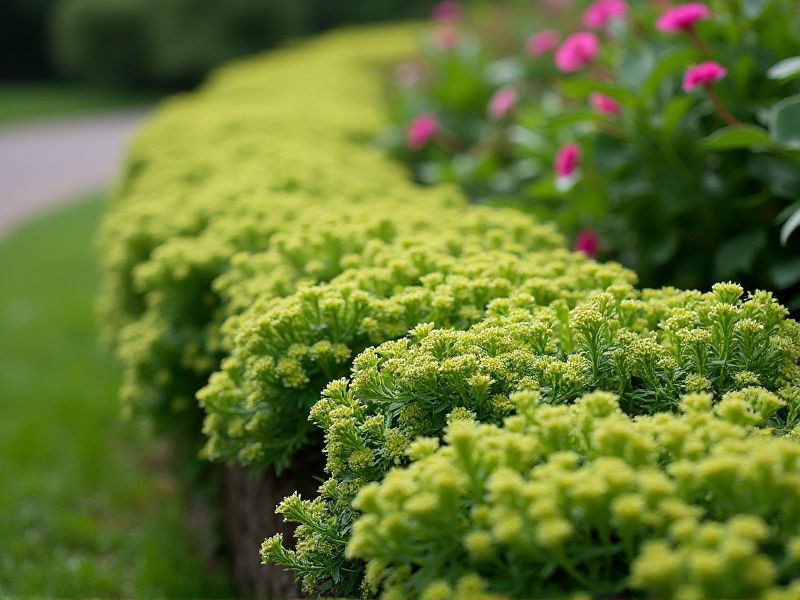
Border plants create visually striking edges in gardens, offering structure and definition to landscapes. Popular choices include lavender, with its aromatic purple flowers attracting pollinators, and boxwood, providing evergreen stability year-round. Ornamental grasses, such as blue fescue, add texture and movement, swaying gently in the breeze. For vibrant color, consider planting marigolds or petunias, which flourish in sunny spots and bloom profusely. You can enhance your garden's appeal by strategically selecting border plants that align with your aesthetic preferences and local climate.
List of some Border plants that accentuate edges
- Hostas (Hosta spp.)
- Lavender (Lavandula spp.)
- Boxwood (Buxus sempervirens)
- Lamb's Ear (Stachys byzantina)
- Heuchera (Heuchera spp.)
- Japanese Forest Grass (Hakonechloa macra)
- Ornamental Grasses (Various spp.)
- Creeping Thyme (Thymus serpyllum)
- Bergenia (Bergenia spp.)
- Lady's Mantle (Alchemilla mollis)
Important things about Border plants that accentuate edges
Plant Height Selection
Choosing the appropriate plant height for border plants is crucial to create visually appealing edges in your garden or landscape. Taller border plants, such as Russian sage or miscanthus grass, serve to add depth and create a striking backdrop, while mid-height options like daylilies and purple coneflowers offer vibrant color within the layer. For a more refined look, low-growing varieties such as creeping thyme or dwarf sedum provide attractive ground cover and contrast beautifully with taller specimens. When selecting your border plants, consider their mature height to ensure a harmonious blend that enhances the overall aesthetic of your outdoor space.
Foliage Color And Texture
Border plants enhance garden edges by adding vibrant foliage colors and diverse textures, creating visual interest and depth. Varieties such as Heuchera showcase stunning leaf colors ranging from deep burgundy to bright lime green, providing year-round appeal. Ornamental grasses like Carex or Miscanthus introduce soft textures and graceful movement, contrasting beautifully with sturdier plants. Selecting a mix of contrasting foliage colors and textures ensures your borders stand out while complementing the overall landscape design.
Seasonal Interest
Border plants play a crucial role in enhancing garden aesthetics by accentuating edges and creating visual appeal. Varieties such as lavender, with its aromatic purple blooms, and ornamental grasses like feather reed grass provide texture while attracting beneficial pollinators. Incorporating perennial flowers like daylilies offers vibrant colors throughout the growing season, ensuring your borders remain lively and inviting. Consider using low-growing ground covers like creeping thyme to soften transitions and prevent soil erosion, all while contributing to a well-defined garden layout.
Growth Habit
Border plants that accentuate edges typically exhibit a variety of growth habits, enhancing garden boundaries and creating visual interest. Low-growing varieties, such as low perennial geraniums, provide a lush carpet and effectively define paths and garden borders. Tall ornamental grasses, like miscanthus, can serve as striking vertical elements, drawing the eye upward while softening hard landscape lines. Selecting a mix of these growth habits not only adds depth but also ensures year-round appeal, as many plants bloom in succession and offer seasonal foliage changes.
Flowering Traits
Border plants play a vital role in landscape design, accentuating the edges of garden beds and pathways with their vibrant flowering traits. Varieties such as Lavender, with its aromatic purple blooms, and Heuchera, offering an array of colorful foliage, create a striking visual contrast that enhances the overall aesthetic. You can also consider perennial options like Salvia, known for its tall spikes of blue and purple flowers, which attract pollinators while providing a dramatic vertical element. Selecting border plants with different blooming times ensures continuous color and interest throughout the seasons, making your garden truly inviting.
Sunlight Requirements
Border plants that accentuate edges thrive best under varying sunlight conditions, depending on the species. For full sun areas, consider vibrant varieties like lavender or daylilies, which not only enhance visibility but also attract pollinators. In partially shaded spots, hostas and astilbes offer lush foliage and stunning blooms, creating a serene border that thrives without direct sunlight. Understanding your garden's light exposure ensures that you choose the right plants to achieve visual appeal and maintain healthy growth throughout the seasons.
Soil Preferences
Border plants thrive best in well-draining soil that provides adequate nutrients and moisture retention. Popular choices include lavender, which flourishes in sandy, loamy soil, while hostas prefer rich, fertile environments. To enhance border design, incorporate plants like agapanthus that thrive in slightly acidic soil, contributing vibrant colors and visual interest. Ensuring your soil composition aligns with the specific needs of these border plants will promote healthy growth and impressive curb appeal.
Watering Needs
Border plants that accentuate edges require careful attention to watering to ensure their vibrant growth and lush appearance. Many popular border plants, such as lavender and daylilies, thrive in well-drained soil, making it essential to water them deeply but infrequently. This encourages deep root development, granting them resilience during dry spells. Regular monitoring of soil moisture levels will help you maintain the ideal balance, ensuring your border plants flourish throughout the growing season.
Pest Resistance
Border plants serve not only as decorative elements but also play a crucial role in pest resistance. By selecting native plants that naturally deter pests, such as marigolds or lavender, you can create a vibrant edge while protecting your garden. These border plants release specific compounds that repel harmful insects and attract beneficial ones, like ladybugs and lacewings. Incorporating a diverse array of these resilient species enhances your landscape's visual appeal and promotes a healthier ecosystem.
Companion Planting Benefits
Border plants are strategically used in companion planting to enhance garden aesthetics while promoting a healthier ecosystem. These edge-dwelling plants can improve soil health by preventing erosion, providing shelter for beneficial insects, and creating habitats for pollinators. By selecting plants like lavender or marigolds, you not only accentuate the edges of your garden but also deter pests and enhance the growth of neighboring crops. Incorporating these companion plants fosters a balanced environment, maximizing the productivity and beauty of your outdoor space.
